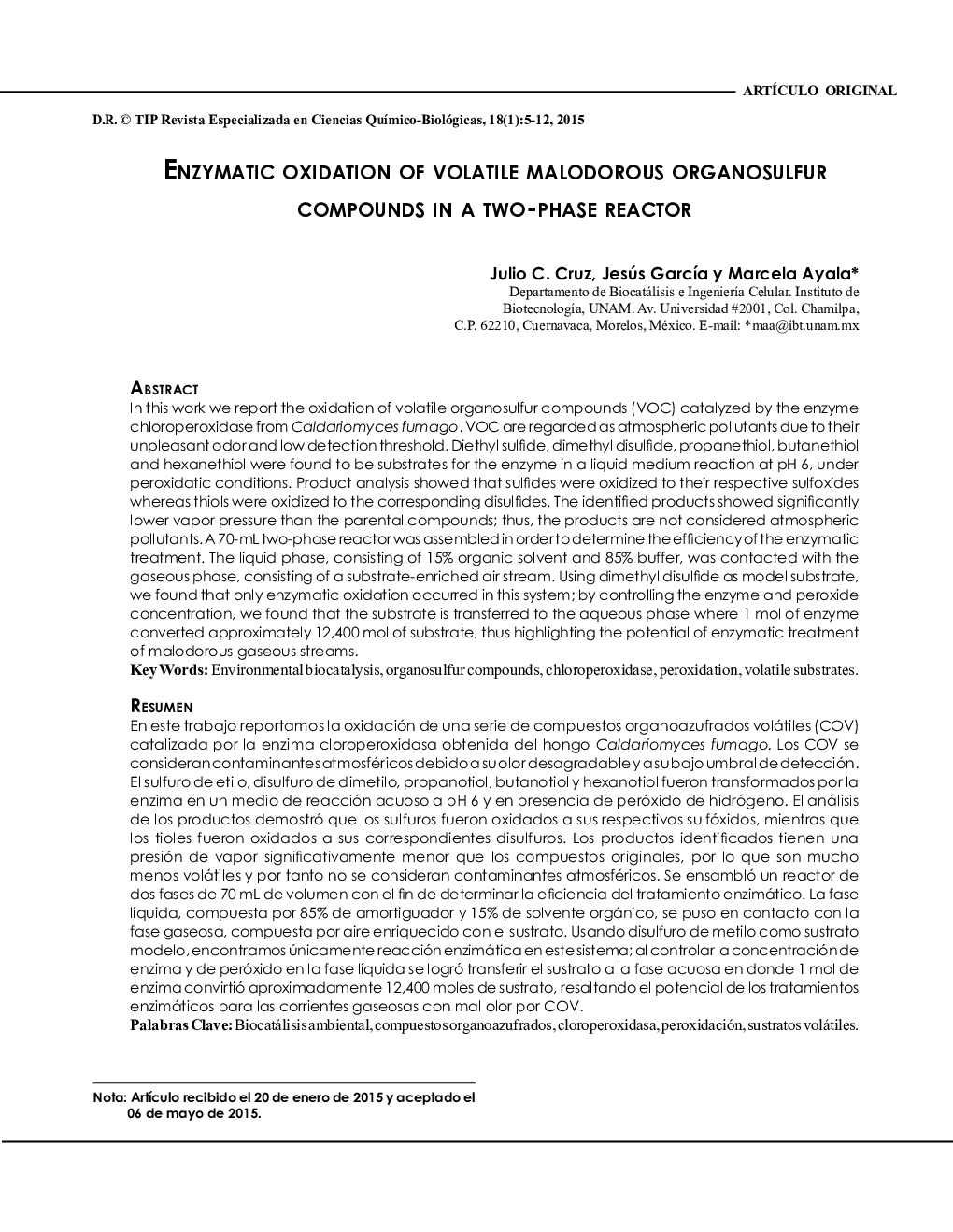| کد مقاله | کد نشریه | سال انتشار | مقاله انگلیسی | نسخه تمام متن |
|---|---|---|---|---|
| 590521 | 878874 | 2015 | 8 صفحه PDF | دانلود رایگان |
In this work we report the oxidation of volatile organosulfur compounds (VOC) catalyzed by the enzyme chloroperoxidase from Caldariomyces fumago. VOC are regarded as atmospheric pollutants due to their unpleasant odor and low detection threshold. Diethyl sulfide, dimethyl disulfide, propanethiol, butanethiol and hexanethiol were found to be substrates for the enzyme in a liquid medium reaction at pH 6, under peroxidatic conditions. Product analysis showed that sulfides were oxidized to their respective sulfoxides whereas thiols were oxidized to the corresponding disulfides. The identified products showed significantly lower vapor pressure than the parental compounds; thus, the products are not considered atmospheric pollutants. A 70-mL two-phase reactor was assembled in order to determine the efficiency of the enzymatic treatment. The liquid phase, consisting of 15% organic solvent and 85% buffer, was contacted with the gaseous phase, consisting of a substrate-enriched air stream. Using dimethyl disulfide as model substrate, we found that only enzymatic oxidation occurred in this system; by controlling the enzyme and peroxide concentration, we found that the substrate is transferred to the aqueous phase where 1 mol of enzyme converted approximately 12,400 mol of substrate, thus highlighting the potential of enzymatic treatment of malodorous gaseous streams.
ResumenEn este trabajo reportamos la oxidación de una serie de compuestos organoazufrados volátiles (COV) catalizada por la enzima cloroperoxidasa obtenida del hongo Caldariomyces fumago. Los COV se consideran contaminantes atmosféricos debido a su olor desagradable y a su bajo umbral de detección. El sulfuro de etilo, disulfuro de dimetilo, propanotiol, butanotiol y hexanotiol fueron transformados por la enzima en un medio de reacción acuoso a pH 6 y en presencia de peróxido de hidrógeno. El análisis de los productos demostró que los sulfuros fueron oxidados a sus respectivos sulfóxidos, mientras que los tioles fueron oxidados a sus correspondientes disulfuros. Los productos identificados tienen una presión de vapor significativamente menor que los compuestos originales, por lo que son mucho menos volátiles y por tanto no se consideran contaminantes atmosféricos. Se ensambló un reactor de dos fases de 70 mL de volumen con el fin de determinar la eficiencia del tratamiento enzimático. La fase líquida, compuesta por 85% de amortiguador y 15% de solvente orgánico, se puso en contacto con la fase gaseosa, compuesta por aire enriquecido con el sustrato. Usando disulfuro de metilo como sustrato modelo, encontramos únicamente reacción enzimática en este sistema; al controlar la concentración de enzima y de peróxido en la fase líquida se logró transferir el sustrato a la fase acuosa en donde 1 mol de enzima convirtió aproximadamente 12,400 moles de sustrato, resaltando el potencial de los tratamientos enzimáticos para las corrientes gaseosas con mal olor por COV.
Journal: TIP - Volume 18, Issue 1, June 2015, Pages 5–12
